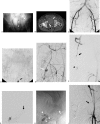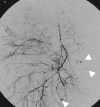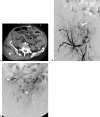Transcatheter embolization in the treatment of hemorrhage in pelvic trauma
- PMID: 21326518
- PMCID: PMC3036439
- DOI: 10.1055/s-0028-1085928
Transcatheter embolization in the treatment of hemorrhage in pelvic trauma
Abstract
Massive hemorrhage related to pelvic trauma is relatively rare, but when it occurs rapid triage to therapeutic intervention is essential for survival. Traditional surgical repairs had limited success. Anatomic and clinical studies indicate that arterial hemorrhage is often identified in patients with hemodynamic instability that do not respond to initial resuscitation. Transcatheter angiography directly identifies arterial injury, and embolization can control retroperitoneal arterial hemorrhage. Stent-graft technology extends the scope of interventional therapy to include rapid and definitive repair of nonexpendable artery injury. Successful management requires coordination between multiple services and the continuation of resuscitative procedures in the angiography suite.
Keywords: Angiography; embolization; hemorrhage; pelvic fracture; trauma.
Figures




Similar articles
-
Impact of mobile angiography in the emergency department for controlling pelvic fracture hemorrhage with hemodynamic instability.J Trauma. 2010 Jan;68(1):90-5. doi: 10.1097/TA.0b013e3181c40061. J Trauma. 2010. PMID: 20065763
-
Predictors of death in patients with life-threatening pelvic hemorrhage after successful transcatheter arterial embolization.J Trauma. 2003 Oct;55(4):696-703. doi: 10.1097/01.TA.0000053384.85091.C6. J Trauma. 2003. PMID: 14566125
-
Arterial embolization is a rapid and effective technique for controlling pelvic fracture hemorrhage.J Trauma. 1997 Sep;43(3):395-9. doi: 10.1097/00005373-199709000-00001. J Trauma. 1997. PMID: 9314298
-
Traumatic injuries: radiological hemostatic intervention at admission.Eur Radiol. 2002 May;12(5):979-93. doi: 10.1007/s00330-002-1427-x. Epub 2002 Mar 23. Eur Radiol. 2002. PMID: 11976842 Review.
-
Arterial bleeding in pelvic trauma: priorities in angiographic embolization.Curr Probl Diagn Radiol. 2012 May-Jun;41(3):93-101. doi: 10.1067/j.cpradiol.2011.07.008. Curr Probl Diagn Radiol. 2012. PMID: 22459889 Review.
Cited by
-
Endovascular Management of Pelvic Trauma.Semin Intervent Radiol. 2021 Mar;38(1):123-130. doi: 10.1055/s-0041-1725112. Epub 2021 Apr 15. Semin Intervent Radiol. 2021. PMID: 33883809 Free PMC article. Review.
-
[Interventional Management for Pelvic Trauma].J Korean Soc Radiol. 2023 Jul;84(4):835-845. doi: 10.3348/jksr.2023.0032. Epub 2023 Jul 14. J Korean Soc Radiol. 2023. PMID: 37559806 Free PMC article. Review. Korean.
-
Prophylactic absorbable gelatin sponge embolization for angiographically occult splenic hemorrhage.Radiol Case Rep. 2018 Jun 4;13(4):753-758. doi: 10.1016/j.radcr.2018.01.005. eCollection 2018 Aug. Radiol Case Rep. 2018. PMID: 30065796 Free PMC article.
-
Transcatheter Arterial Embolization for Bleeding Related to Pelvic Trauma: Comparison of Technical and Clinical Results between Hemodynamically Stable and Unstable Patients.Tomography. 2023 Sep 1;9(5):1660-1682. doi: 10.3390/tomography9050133. Tomography. 2023. PMID: 37736986 Free PMC article.
-
"Beyond saving lives": Current perspectives of interventional radiology in trauma.World J Radiol. 2017 Apr 28;9(4):155-177. doi: 10.4329/wjr.v9.i4.155. World J Radiol. 2017. PMID: 28529680 Free PMC article. Review.
References
-
- Sclafani S J, Becker J A. Interventional radiology in the treatment of retroperitoneal trauma. Urol Radiol. 1985;7(4):219–230. - PubMed
-
- Matalon T S, Athanasoulis C A, Margolies M N, et al. Hemorrhage with pelvic fractures: efficacy of transcatheter embolization. AJR Am J Roentgenol. 1979;133(5):859–864. - PubMed
-
- Looser K G, Crombie H D., Jr Pelvic fractures: an anatomic guide to severity of injury. Review of 100 cases. Am J Surg. 1976;132(5):638–642. - PubMed
-
- Mucha P, Jr, Farnell M B. Analysis of pelvic fracture management. J Trauma. 1984;24(5):379–386. - PubMed
-
- Moreno C, Moore E E, Rosenberger A, Cleveland H C. Hemorrhage associated with major pelvic fracture: a multispecialty challenge. J Trauma. 1986;26(11):987–994. - PubMed

